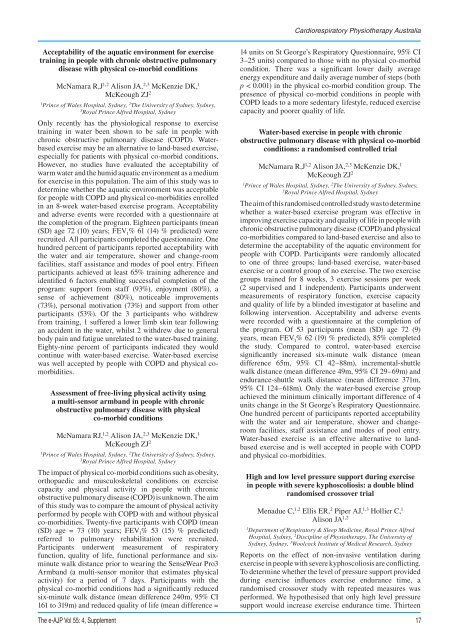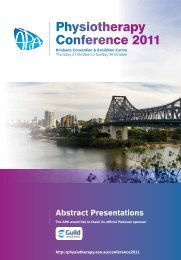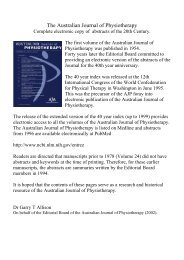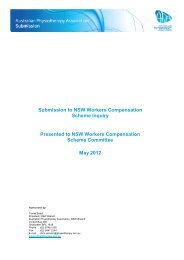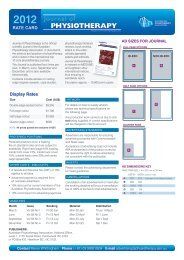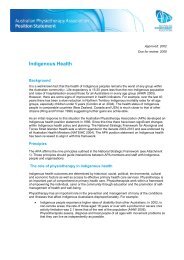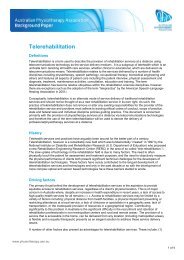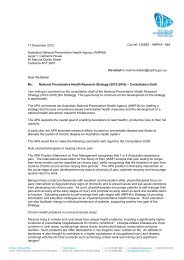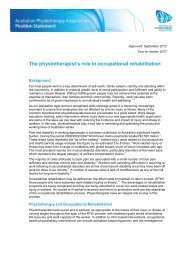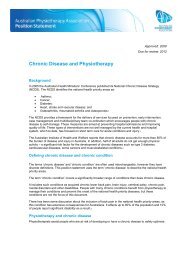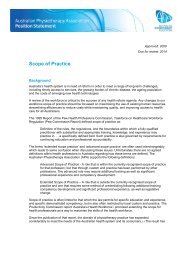2009 APA Conference Week Abstracts - Australian Physiotherapy ...
2009 APA Conference Week Abstracts - Australian Physiotherapy ...
2009 APA Conference Week Abstracts - Australian Physiotherapy ...
You also want an ePaper? Increase the reach of your titles
YUMPU automatically turns print PDFs into web optimized ePapers that Google loves.
Cardiorespiratory <strong>Physiotherapy</strong> Australia<br />
Acceptability of the aquatic environment for exercise<br />
training in people with chronic obstructive pulmonary<br />
disease with physical co-morbid conditions<br />
McNamara R,J 1,2 Alison JA, 2,3 McKenzie DK, 1<br />
McKeough ZJ 2<br />
1<br />
Prince of Wales Hospital, Sydney, 2 The University of Sydney, Sydney,<br />
3<br />
Royal Prince Alfred Hospital, Sydney<br />
Only recently has the physiological response to exercise<br />
training in water been shown to be safe in people with<br />
chronic obstructive pulmonary disease (COPD). Waterbased<br />
exercise may be an alternative to land-based exercise,<br />
especially for patients with physical co-morbid conditions.<br />
However, no studies have evaluated the acceptability of<br />
warm water and the humid aquatic environment as a medium<br />
for exercise in this population. The aim of this study was to<br />
determine whether the aquatic environment was acceptable<br />
for people with COPD and physical co-morbidities enrolled<br />
in an 8-week water-based exercise program. Acceptability<br />
and adverse events were recorded with a questionnaire at<br />
the completion of the program. Eighteen participants (mean<br />
(SD) age 72 (10) years; FEV 1 % 61 (14) % predicted) were<br />
recruited. All participants completed the questionnaire. One<br />
hundred percent of participants reported acceptability with<br />
the water and air temperature, shower and change-room<br />
facilities, staff assistance and modes of pool entry. Fifteen<br />
participants achieved at least 65% training adherence and<br />
identified 6 factors enabling successful completion of the<br />
program: support from staff (93%), enjoyment (80%), a<br />
sense of achievement (80%), noticeable improvements<br />
(73%), personal motivation (73%) and support from other<br />
participants (53%). Of the 3 participants who withdrew<br />
from training, 1 suffered a lower limb skin tear following<br />
an accident in the water, whilst 2 withdrew due to general<br />
body pain and fatigue unrelated to the water-based training.<br />
Eighty-nine percent of participants indicated they would<br />
continue with water-based exercise. Water-based exercise<br />
was well accepted by people with COPD and physical comorbidities.<br />
Assessment of free-living physical activity using<br />
a multi-sensor armband in people with chronic<br />
obstructive pulmonary disease with physical<br />
co-morbid conditions<br />
McNamara RJ, 1,2 Alison JA, 2,3 McKenzie DK, 1<br />
McKeough ZJ 2<br />
1<br />
Prince of Wales Hospital, Sydney, 2 The University of Sydney, Sydney,<br />
3<br />
Royal Prince Alfred Hospital, Sydney<br />
The impact of physical co-morbid conditions such as obesity,<br />
orthopaedic and musculoskeletal conditions on exercise<br />
capacity and physical activity in people with chronic<br />
obstructive pulmonary disease (COPD) is unknown. The aim<br />
of this study was to compare the amount of physical activity<br />
performed by people with COPD with and without physical<br />
co-morbidities. Twenty-five participants with COPD (mean<br />
(SD) age = 73 (10) years; FEV 1 % 53 (15) % predicted)<br />
referred to pulmonary rehabilitation were recruited.<br />
Participants underwent measurement of respiratory<br />
function, quality of life, functional performance and sixminute<br />
walk distance prior to wearing the SenseWear Pro3<br />
Armband (a multi-sensor monitor that estimates physical<br />
activity) for a period of 7 days. Participants with the<br />
physical co-morbid conditions had a significantly reduced<br />
six-minute walk distance (mean difference 240m, 95% CI<br />
161 to 319m) and reduced quality of life (mean difference =<br />
14 units on St George’s Respiratory Questionnaire, 95% CI<br />
3–25 units) compared to those with no physical co-morbid<br />
condition. There was a significant lower daily average<br />
energy expenditure and daily average number of steps (both<br />
p < 0.001) in the physical co-morbid condition group. The<br />
presence of physical co-morbid conditions in people with<br />
COPD leads to a more sedentary lifestyle, reduced exercise<br />
capacity and poorer quality of life.<br />
Water-based exercise in people with chronic<br />
obstructive pulmonary disease with physical co-morbid<br />
conditions: a randomised controlled trial<br />
McNamara R,J 1,2 Alison JA, 2,3 McKenzie DK, 1<br />
McKeough ZJ 2<br />
1<br />
Prince of Wales Hospital, Sydney, 2 The University of Sydney, Sydney,<br />
3<br />
Royal Prince Alfred Hospital, Sydney<br />
The aim of this randomised controlled study was to determine<br />
whether a water-based exercise program was effective in<br />
improving exercise capacity and quality of life in people with<br />
chronic obstructive pulmonary disease (COPD) and physical<br />
co-morbidities compared to land-based exercise and also to<br />
determine the acceptability of the aquatic environment for<br />
people with COPD. Participants were randomly allocated<br />
to one of three groups: land-based exercise, water-based<br />
exercise or a control group of no exercise. The two exercise<br />
groups trained for 8 weeks, 3 exercise sessions per week<br />
(2 supervised and 1 independent). Participants underwent<br />
measurements of respiratory function, exercise capacity<br />
and quality of life by a blinded investigator at baseline and<br />
following intervention. Acceptability and adverse events<br />
were recorded with a questionnaire at the completion of<br />
the program. Of 53 participants (mean (SD) age 72 (9)<br />
years, mean FEV 1 % 62 (19) % predicted), 85% completed<br />
the study. Compared to control, water-based exercise<br />
significantly increased six-minute walk distance (mean<br />
difference 65m, 95% CI 42–88m), incremental-shuttle<br />
walk distance (mean difference 49m, 95% CI 29–69m) and<br />
endurance-shuttle walk distance (mean difference 371m,<br />
95% CI 124–618m). Only the water-based exercise group<br />
achieved the minimum clinically important difference of 4<br />
units change in the St George’s Respiratory Questionnaire.<br />
One hundred percent of participants reported acceptability<br />
with the water and air temperature, shower and changeroom<br />
facilities, staff assistance and modes of pool entry.<br />
Water-based exercise is an effective alternative to landbased<br />
exercise and is well accepted in people with COPD<br />
and physical co-morbidities.<br />
High and low level pressure support during exercise<br />
in people with severe kyphoscoliosis: a double blind<br />
randomised crossover trial<br />
Menadue C, 1,2 Ellis ER, 2 Piper AJ, 1,3 Hollier C, 1<br />
Alison JA 1,2<br />
1<br />
Department of Respiratory & Sleep Medicine, Royal Prince Alfred<br />
Hospital, Sydney, 2 Discipline of <strong>Physiotherapy</strong>, The University of<br />
Sydney, Sydney, 3 Woolcock Institute of Medical Research, Sydney<br />
Reports on the effect of non-invasive ventilation during<br />
exercise in people with severe kyphoscoliosis are conflicting.<br />
To determine whether the level of pressure support provided<br />
during exercise influences exercise endurance time, a<br />
randomised crossover study with repeated measures was<br />
performed. We hypothesised that only high level pressure<br />
support would increase exercise endurance time. Thirteen<br />
The e-AJP Vol 55: 4, Supplement 17


